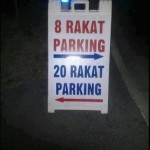-
Evidence for 20 Rak’ahs Taraweeh
By Ahmed ibn Muhammad
Categories : Fiqh
Nasir al-Albani’s slanderous declaration that
the companions’ unanimous practice of
20 rak’ahs of Taraweeh is a reprehensible
innovation (bid’ah)!Ahmed ibn Muhammad
It has been discussed previously in Al-Albani Unveiled, and by the admission of his own followers, that al-Albani has declared the practice of 20 rak’ahs oftaraweeh prayer in the holy month of Ramadan to be a reprehensible innovation (bid’ah)! What concerns us here is not the actual number of rak’ahs, but the consideration that he has over reached himself by declaring a known practice of the Sahaba (may Allah be pleased with them) to be a bid’ah! To any sane, sincere and objective minded reader the implication of his claim is clear, namely, he has declared the unanimous practise of the bid’ah! Allah forbid.
We will discuss, insha’Allah, what he actually said and prove to him and his blind followers that they are the ones who deliberately overlook Sahih Hadiths on this issue, as well as avoiding the practice and Consensus of the venerable Companions, and our beloved Messenger, Muhammad (peace and blessings be upon him) who initiated this practice and number. This issue is no doubt a critical test for those who claim to be on the path of the venerable Companions and their Succesors. May Allah be pleased with them all.
Evidence for 20 rak’ahs of Taraweeh from authentic ahadith
In the following synopsis we will provide the most authentic evidence to support the claims of the Hanafi, Maliki, Shafi’i, Hanbali and Zahiri[1] schools of Islamic jurisprudence, and most importantly that the Prophet (peace and blessings of Allah be upon him) and in the unanimous view and practice of the Sahaba (may Allah be pleased with them all) the rak’ahs of taraweeh are twenty.
The narration’s that will be presented have the stamp of authentication by at least ten distinguished scholars. Al-Imam al-Hafiz Jamaluddin al-Zayla’i[2] has recorded in his book Nasb ur-Rayah[3] that:
“Al-Bayhaqi has related in al-Marifa [4]
(via the following chain of transmission):
Abu Tahir al-Faqih -> Abu Uthman al-Basri -> Abu Ahmad Muhammad ibn Abdal Wahhab -> Khalid ibn Mukhallad -> Muhammad ibn Ja’far -> Yazid ibn Khaseefah -> Sa’eeb ibn Yazid,
who said:
‘In the time of Umar ibn al-Khattab (radiallahu anhu) the people used to observe 20 rak’ahs and the witr.‘
Al-Nawawi said in al-Khulasa:
‘Its Isnad is Sahih.'”
Hafiz al-Zayla’i has also mentioned after reporting the authenticity of this Hadith, that Imam al-Bayhaqi has also reported another version of the above narration through a different channel of transmission, in his Sunan al-Kubra. The narration referred to has been mentioned in the footnotes by the council of Islamic scholars (Majlis al-Ulama) who edited Nasb ur-Rayah[5], in the following words:
“(Bayhaqi) has related in al-Sunan [6] (via the following isnad):Abu Abdullah al-Hussain ibn Muhammad ibn al-Hussain finjuwayh al-Dinawari – Ahmad ibn Muhammad ibn Ishaq al-Sunni – Abdullah ibn Muhammad ibn Abdul Aziz al-Baghawi – Ali ibn al-J’ad – Ibn Abi Dhib – Yazid ibn Khaseefah – Sa’eeb ibn Yazid,
who said:
“In the time of Umar ibn al-Khattab, radiallahu anhu, they would perform 20 rak’ats in the month of Ramadan. He said (also): And they would recite the Mi’in [7] , and they would lean on their sticks in the time of Uthman ibn Affan, radiallahu anhu, from the discomfort of standing.”
All the men in the (above) isnad are trustworthy, as mentioned by the Indian research scholar, Shaykh al-Nimawi[8], in Athar al-Sunan[9].”
The evidence which proves that Umar (radiallahu anhu) ordered the practise of 20 rak’ahs has been recorded by Shaykh Ali al-Muttaqi al-Hindi[10] in the largest collection of Hadith available today: Kanz al-Ummal fi Sunan al-aqwal wal Af’al[11], as follows from Ubayy ibn Ka’b (radiallahu anhu):
“Umar (radiallahu anhu) ordered him (Ubayy) to lead the people in prayer at night in Ramadan, because the people fast during the day and can not recite (the Qur’an) well, therefore it is better that you should recite (the Qur’an) during the night. I (Ubayy) asked: “O commander of the believers, this thing was not done before.” He said: “I know, but it is a good practise”, and so (Ubayy) led (the Companion’s) for 20 rak’ahs.“
There are many other narration’s which prove the case for twenty rak’ahs, but some of these narrations are less authentic than others, nevertheless they are weighty enough to back each other up and raise the level of authentication to at least Hasan (good); as Shaykh Nimawi and others have verified.
For the readers benefit one may refer to the following books of Hadith for at least 25 further proofs:
- Muwatta Imam Malik from Yazid ibn Ruman [12]
- Sunan al-Kubra of Imam al-Bayhaqi [13] from: Ibn Abbas, Yazid ibn Ruman (same as Imam Malik’s narration), Suwayd ibn Ghaflah, Ali ibn Abi Talib etc. Also refer to Marifatus Sunan of al-Bayhaqi.
- Musannaf of Imam Abdur Razzaq [14] from: Sa’eeb ibn Yazid and al-Hasan.
- Musannaf of Imam Ibn Abi Shaibah [15] from some 13 different isnads.
- Qiyam ul-lail[16] of Imam Muhammad ibn Nasr al-Marwazi from: Sa’eeb ibn Yazid, Yazid ibn Ruman, Ibn Mas’ud, A’mash al-Kufi, Ibn Sirin, Malik, al-Shafi’i and others.
A selection of the scholars of Hadith who authenticated and used al-Bayhaqi’s narrations as a proof for 20 rak’ahs of Taraweeh
- Imam Yahya al-Nawawi (d. 676 AH)He has authenticated the narration recorded and mentioned above from al-Bayhaqi’s Marifatus-Sunan, in his book al-Khulasa – this was mentioned by Hafiz al-Zayla’i in Nasb ur-Rayah (see above). Besides this narration, he has also recorded the alternative narration recorded by Imam al-Bayhaqi in his Sunan al-Kubra.
He has declared this variant narration to be a decisive argument and proof for the Shafi’i Madhhab, as well as saying: “Its Isnad is Sahih”, in his voluminous work: al-Majmu’ Sharh al-Muhadhhab [17].
- Imam Jamaluddin Yusuf al-Zayla’i (d. 762 AH)We have mentioned above that Hafiz al-Zayla’i in his analysis of the narration’s found in the Hanafi fiqh book: al-Hidaya, has recalled the narration from al-Bayhaqi’s Marifatus-Sunan, and quoted Imam al-Nawawi as his authority to declare this narration to be Sahih.
- Imam Badruddin al-Ayni (d. 855 AH)He said in his famous commentary to Sahih al-Bukhari: Umdat ul-Qari[18] :
“The argument of our companions (the Hanafi scholars) as well as the Shafi’is and Hanbalis is what al-Bayhaqi has related with an authentic chain of transmission (Sahih Isnad)…”
- Imam Ali al-Qari (d. 1014 AH)He has noted in Sharhul-Nuqayah[19] :
“Imam al-Bayhaqi has reported on genuine authority (Sahih) the performing of 20 rak’ahs of Taraweeh during the periods of Umar, Uthman and Ali (may Allah be pleased with them), and hence there has been consensus on it.”
- Imam Kamaluddin ibn al-Humam (d. 861 AH)Imam Ibn al-Humam asserts that it has been established from genuine authority (sahih) that the Companions and their Successors used to say 20 rak’ahs of Taraweeh during the auspicious time of Umar (radiallahu anhu); this authority of Yazid ibn Ruman (as in Imam Malik’s narration) has been reported from Sa’eeb ibn Yazid that, “During Umar’s auspicious time we used to say 20 rak’ahs.” The genuineness of this authority has been verified by Imam Nawawi in the synopsis [20].
- Imam Taqi al-Din as-Subki (d. 756 AH)
- Zayn al-Din al-Iraqi (d. 806 AH) and
- Jalaluddin as-Suyuti (d. 911 AH)According to Imam Abdal Hayy Lucknawi[21] in his work Tuhfatul Akhyar[22], Imam Nawawi, Iraqi and Suyuti[23] have all considered Bayhaqi’s narration as reported in his Sunan al-Kubra to be Sahih.
Shaykh Habibur Rahman al-A’zami has also affirmed that Nawawi, Iraqi and Suyuti have declared Imam al-Bayhaqi’s narration to be Sahih. He has also reported that Imam al-Subki [24] and Mullah Ali al-Qari have both declared the alternative narration recorded by Bayhaqi in his Marifatus Sunan to be Sahih[25].
- Imam Muhammad Shauq Nimawi (d. 1322 AH)We have mentioned previously that Shaykh Nimawi has declared Imam al-Bayhaqi’s narration to be Sahih in Athar al-Sunan [26].
- Imam Ibrahim al-Halabi (d. 956 AH)He has noted in al-Kabiri[27] :
“The argument of the majority of people is the report which Imam al-Bayhaqi has reported with sound authority (Sahih), that during Umar as well as Uthman and Ali’s (may Allah be pleased with them), 20 rak’ahs was performed.”
Other contemporary
Other prominent scholars who have used Imam al-Bayhaqi’s narrations, besides other proofs include: Shaykh Habibur Rahman al-A’zami (see above), Shaykh Isma’il Ansari (see later), Shaykh al-Muqri in Tahqeeq al-Taraweeh, Shaykh Zafar Ahmad Uthmani in his monumental I’la as-Sunan[28], Shaykh Abdur Rahim Lajpuri in Fatawa al-Rahimiyya[29], Shaykh Ahmad Khan in Ja’al Haqq[30], Shaykh Taqi al-Uthmani in Dars-e-Tirmidhi[31] and many others.
A writer once claimed that Imam al-Bukhari held the view that the rak’ahs of Taraweeh were eight, excluding the witr. What is surprising to note is that despite his bold ascription of this view to Imam al-Bukhari, he did not furnish one shed of proof or reference to the works of Imam al-Bukhari to verify his claim.
On the contrary, the commentators of Sahih al-Bukhari, like Hafiz Ibn Hajar and Hafiz al-Ayni have not ascribed any view for 8 rak’ahs to Imam al-Bukhari to our knowledge. What is unsurprising to note is that the two aforementioned scholars of Hadith have mentioned the proofs in favour of 20 rak’ahs. One may raise the catechism – if Imam al-Bukhari had held the view ascribed to him, would there be no doubt that his great student, Imam Abu Isa al-Tirmidhi[32], would not have failed to mention this?
For we know that Imam al-Tirmidhi only knew of either 20 or 41 rak’ahs [33] in his time.
He has recorded in al-Jami us-Sahih, that Umar[34], Ali (may Allah be pleased with them) and other Companions of the Prophet (peace be upon him) used to perform 20 rak’ahs of Taraweeh, as well as saying that Sufyan al-Thauri (d. 161 AH), Abdullah ibn al-Mubarak (d. 181 AH) and al-Shafi’i (d. 204 AH) held the same view. He has also quoted Imam al-Shafi’i as saying that he saw the people of Makkah performing 20 rak’ahs of Taraweeh.
The only proof to suggest that the Holy Prophet (peace and blessings be upon him) performed 20 rak’ahs has been reported on the authority of Abdullah ibn Abbas (radiallahu anhu):
“Verily, the Holy Prophet (peace be upon him) in the month of Ramadan, used to perform 20 rak’ahs and the witr (afterwards) without congregation.”[35]
This narration has been shown to have a weak (da’eef) isnad by the verifying scholars like al-Hafiz Ibn Hajar al-Asqalani [36], Hafiz al-Zayla’i and others, due to the presence of the narrator: Abu Shaiba[37] Ibrahim ibn Uthman. He was the grandfather of the Imam of Hadith: Abu Bakr ibn Abi Shaiba, as well as being a Qadi; but as for his status as a reporter of Hadith, he has been declared to be discarded (matrook) by Hafiz Ibn Hajar in Taqreeb ul-Tahdhhib[38] and al-Bayhaqi has declared him to be weak in al-Sunan al-Kubra[39].
One may wish to note that al-Albani has gone to the added length of declaring Ibn Abbas’ narration to be Maudu (fabricated) [40], whereas no previous scholars of Hadith have gone beyond declaring its isnad to be da’eef (weak). This is nothing strange, for al-Albani usually goes to the added lengths and extremities of declaring narrations which do not suit his whims and desires to be either da’eef or maudu.
An interesting study prepared and published on this issue by a Shaykh who is said to have memorized the six most authentic collections of Hadith, is available to verify this assertion.
Let us now see what a number of Imams of sacred law have said about the aforementioned narration from Ibn Abbas (radiallahu anhu).
- Imam Ahmad al-Tahtawi[41] has said in Sharh Durr al-Mukhtar[42]
“On the authority of Ibn Abbas’ statement, 20 rak’ahs of Taraweeh has been estblished from the Holy Prophet’s (peace be upon him) practice.“
- Shaykh Abdal Haqq al-Dehlawi[43] has been quoted by the author of Fatawa Rahimiyya [44] as follows: “Shaykh Abdul Haqq Muhaddith of Delhi writes in his book, Fath-e-Sirr-ul-Mannan:
‘The obvious thing is that, according to the holy Companions, the Holy Prophet’s (peace be upon him) saying 20 rak’ahs had been established, as is mentioned in Ibn Abbas’ tradition, and for this reason Umar (radiallahu anhu) adopted 20 rak’ahs . . .‘
He also quoted Shaykh Abdal Haqq as saying from his book: Ma sabata minas Sunnah[45],
‘According to our belief, the taraweeh consists of 20 rak’ahs, for Bayhaqi has reported with sound authority that the holy Companions (may Allah be pleased with them) used to perform 20rak’ahs during Umar’s time; moreover, this practice continued during Uthman and Ali’s (may Allah be pleased with them) periods also.‘”
- Shaykh Abdur Rahim continued to say in his Fatawa:
“The fact is that Hadrat Ibn Abbas and Hadrat Umar are both Companions; there is no ‘weak’ narrator between them, wherefore Ibn Abbas’ tradition may be called weak and the Companion’s action may be considered to be based on a weak tradition. Their action was based on a sound basis; how can those who follow them be called ‘the deluded’? In short, according to the Companion’s reckoning, the afore said hadith is not at all weak, though, due to the inclusion later of a weak narrator. Ibrahim ibn Uthman may be according to the latter-day authorities called weak ‘by way of narration’, but ‘intelligibly’ it must be authentic because the well-guided Caliphs and other Companion’s conformity to and continuance of 20 rak’ahs is the proof of its being reliable.
Allamah Bahrul-Ulum[46] says:
‘The Companions continued conformity to 20 rak’ahs is the context and sign of the soundness of this tradition.’“
In support of what we have mentioned, let us quote to you what a leader of Salafiyyism has mentioned in his book: Criticism of Hadith among Muslims with reference to Sunan Ibn Maja[47] :
“Shafi’i also recognizes a weak Hadith as authentic (sahih) if it is found to be accepted by the whole ummah (see al-Sakhawi: Fath al-Mugith). But he does not accept Malik’s view of restricting the practise to the people of Madinah. According to the later scholars of the Hanafi school like Ibn al-Humam, a Hadith will be declared Sahih, if it is supported by the practise of the Ummah (see Abdal Rashid Nu’mani: Ma tamusu ilaihe al-Haja, p. 18). Among traditionalists, Tirmidhi often remarks, after quoting a less authentic Hadith:
‘It is being practised by the people of learning (Ahl-ul-Ilm).’ Suyuti deduces: ‘It indicates that the Hadith is supported by the sayings of the people of learning. More than one scholar has said that a Hadith is declared Sahih if supported by the sayings of the people of learning, even if it lacks a proper Isnad (see Suyuti: al-Ta’aqubat, folio 20).'”
In closing this section, consider what Imam Abu Hanifah (rahimahullah) said to his student Imam Abu Yusuf (rahiamhullah). Shaykh Anwar Shah Kashmiri stated in Fayd ul-Bari Sharh Sahih al-Bukhari:
“Imam Abu Yusuf (rahimahullah) asked Imam Abu Hanifah (rahimahullah), ‘Did Hadrat Umar (radiallahu anhu) have any compact from the Holy Prophet (peace and blessings of Allah be upon him) for 20 rak’ahs of Taraweeh?’ The Imam replied, ‘Hadrat Umar (radiallahu anhu) was not one to invent on his own; certainly he had some proof for this!'” [48]
Ijma us-Sahabah
A number of Imams of sacred law have inferred from the evidences available, that there is a definite consensus of the Companions (Ijma us-Sahabah)[49] on this issue. For the readers benefit we will provide some quotes below (including one from a “Salafi” writer).
- Imam Ali ul-Qari al-Hanafi (d. 1014 AH)He said in Sharh ul-Nuqayah[50]:
“Imam Bayhaqi has reported on genuine authority (sahih) about the performance of 20 rak’ahs of Taraweeh during the periods of Umar, Uthman and Ali (may Allah be pleased with them), and hence there has been consensus (Ijma) on it.“
- Shaykh ul-Islam Ibn Hajar al-Haytami (d. 974 AH)Allamah Abdal Hayy Lucknawi has reported in Tuhfat ul-Akhyar[51] and in his Majmu’ Fatawa[52], the fact that Hafiz Ibn Hajar al-Haytami has declared Ijma us-Sahabah on the rak’ahs of Taraweeh being twenty.
- Imam Muwaffaq al-Din Ibn Qudama al-Maqdisi (d. 620)The leading Imam of the Hanbalis in his time has declared in his famous book of fiqh: al-Mughni[53] :
“There has been the Companion’s consensus (Ijma us-Sahabah) on 20 rak’ahs of Taraweeh.“
- Shaykh Bahrul-Ulum Abdul Ali ibn Nizamuddin (d. 1235)He said in Rasa’il ul-Arkan[54]:
“Then there was unanimity regarding the 20 rak’ahs.“
- Shah Abdul Aziz Dehlawi[55] (d. 1824 CE)He has declared in his Majmu’ Fatawa Azizi [56] :
“Thereafter, they (the Companions) adopted twenty (rak’ahs of Taraweeh) and three rak’ahs (ofwitr), on which number consensus had been formed.“
- Shaykh Qutubuddin Khan (d. 1289 AH):
He has stated in his commentary to the Hadith collection known as Mishkat ul-Masabih: Madhahir ul-Haqq [57] :“But the Companions consensus was formed on this that the Taraweeh consists of 20 Rak’ahs.“
- Imam Kamaluddin ibn al-Humam (d. 861 AH)He has said in Fathul-Qadir[58] :
“At last unanimity was formed on 20 rak’ahs of prayer and this alone is in succession.“
- Imam Malik ibn Anas (d. 179 AH)It was written in the most authentic record of Imam Malik’s most accurate sayings[59], known as al-Mudawwanah al-Kubrah:
“Ibn al-Qasim said, ‘The rak’ahs (of taraweeh) with witr are thirty nine.’ Imam Malik said, ‘This is what the people have agreed upon from amongst the predecessors, and the people have not stopped doing it.’” [60]
- Shaykh Shabir Ahmad al-Uthmani (d. 1369 AH)Shaykh Abdur Rahim said in his Fatawa[61] :
“Allamah Shabir Ahmad Uthmani says that none of the Companions ever took exception to 20rak’ahs, and hence all of them were unanimous on twenty rak’ahs.“[62]
- Nawab Siddiq Hasan Khan Bhopali (d. 1307 AH)
He was one of the leading personalities of the “Salafi” movement in India. It has been recorded by him in his Awnu’l Bari[63] :
“The practice of 20 rak’ahs established during Hadrat Umar’s time has been considered by the Ulama as consensus.“
All praise be to Allah, the synopsis of the proofs, their authenticity and the resulting of Ijma us-Sahabah, has been demonstrated by way of recoursing to some of the most reputable scholars of the various Madhhabs of this blessed Ummah.
I (Ahmed ibn Muhammad) asked my teacher, the faqih, Shaykh Muhammad Asaddar Ali (b. 1911), may Allah preserve him:“What do you say about those people who claim to be the followers of the pious predecessors (Salaf us-Salihin), but insist on praying 8 rak’ahs of Taraweeh year in year out?” He replied:
“I take it you are referring to those people who go around with the title ‘Salafi’ over their heads. I will say a few things about these pseudo-Salafites. They are violators of the Companions (may Allah be pleased with them) consensus on this and other issues – just as their master Ibn Taymiyya was; and the scholars of the past have declared the violators of the Ijma us-Sahabahto be either corrupt innovators or even unbelievers – depending on the nature of the question. The Muhaddith, Shaykh Abdal Hayy Lucknawi (rahimahullah) has declared in his Taliqatul-Hidaya[64] : ‘One who performs 8 rak’ahs of Taraweeh will be an abandoner of the insisted sunnah.’ So, if you come across a man who has been shown the proofs and what the vast majority of scholars, including the Imams like Abu Hanifah, Malik, Shafi’i and Ahmad ibn Hanbal have said; but still persists on avoiding the Companions unanimity on 20 rak’ahs of Taraweeh, and prefers 8 rak’ahs – then know that he is not a Salafi, rather a follower of his desires and avoider of the Companion’s (may Allah be pleased with them) unanimous practice. And Allah knows best.“
O believers, have we not heard that Allah has said:
“O you who believe, Obey Allah, and obey the Messenger, And those charged with authority among you. If you differ in anything among yourselves, refer it to Allah and His Messenger, if ye do believe in Allah and the Last Day: That is best, and most suitable for final determination”[65]
O believers, have we not heard that Allah’s Messenger (peace and blessings of Allah be upon him) has said on two occasions:
“Hold fast to my Sunnah and the Sunnah of the Rightly Guided Caliphs[66], clamp your molars upon it, avoid new novelties, for every novelty is an innovation, and every innovation is misguidance.” [67]
“Allah will never let my Ummah agree upon misguidance, and the hand of Allah is over the group (Jama’ah), so follow the great mass of believers (Sawad ul-‘Azam), and whoever dissents from them departs to hell.” [68]
We will finish this section by mentioning the titles of two books written on this issue. The first is a book written by a Qadi at the Shariah court in Medinah al-Munawwara, as well as being a lecturer in the Holy Prophet’s (peace and blessings be upon him) mosque – Shaykh Atiyya Muhammad Salim, and the second is by – Shaykh Isma’il ibn Muhammad al-Ansari. As the title below suggests, al-Ansari’s book is a refutation of al-Albani’s research and views on this issue.
- Al-Taraweeh – Akthar min alf Aam fi Masjid al-Nabi alaihis-salatu wa sallam[69].
- Tashih Hadith Salatul– Taraweeh Ishrin Rak’ah wa’l Radd ala al-Albani fi Tadaeefah[70].
Finally, the reader may be interested to know that even today, just as in the time of the Salaf us-Salihin (may Allah be well pleased with them), 20 rak’ahs of taraweeh is still being adhered to in Makkah and Madinah.
May Allah keep us on the practice of the Companions and guide those who deliberately avoid so and claim to be on the path of the righteous Salaf. Amin.

Notes
- The view that Imam’s Abu Hanifah, Malik, Shafi’i, Ibn Hanbal and Dawud al-Zahiri all preferred 20 rak’ahs of taraweehexcluding the witr has been mentioned by Qadi Ibn Rushd in Bidayat al-Mujtahid (1/239).
- He was a famous Hanafi Hafiz of Hadith, as well as being one of the teachers of Ibn Hajar al-Asqalani. He died in the year 762 AH, rahimahullah.
- 2/154, Majlis al-Ulama, India, 4 vols. 1357 AH.
- The full title is al-Marifatus-Sunan wa’l athar.
- 2/154, footnote 2.
- 2/496.
- A group of medium sized chapters from the Qur’an.
- His full name was Muhammad Shauq al-Nimawi; (d. 1322 AH – rahimahullah).
- 2/54.
- He died in the year 975 AH, rahimahullah.
- 4/284, no. 5787 (8 vols. 1st edn; Hyderabad, India, 1312-14 AH), reported by him on the authority of the Muhaddith, Ibn Man’i.
- This report is very similar to Bayhaqi’s narration (see Muwatta, 6.2, no. 5, p. 48, English edn.).
- 2/496-7.
- 4/260-3, no’s. 7730-1 & 7733.
- 2/392-4. Printed in Hyderabad, India, 1387/1967.
- PP. 91-2, India, 1320 AH.
- 4/32-3, printed with Imam al-Rafi’i’s (d. 623 AH) Fath al-Aziz and Hafiz Ibn Hajar al-Asqalani’s Talkhis ul-habir in the footnotes; Idara al-Tibat al-Muniriyyah, Egypt.
- 7/178, Idara al-Tibat al-Muniriyyah, Egypt.
- 1/104.
- Quoted in Fatawa Rahimiyya (1/241) of Mufti Abdur Rahim; on the authority of Ibn al-Humam’s Fath al-Qadir (1/407).
- He was a celebrated Indian Muhaddith who has also been recognised by the “Salafiyya” for his services to Islam. He passed away in 1304 AH. Rahimahullah.
- P. 192, quoted in Is Taraweeh 20 raka’ats? p. 22, Madrasah Arabia Islamia, Azadville, South Africa.
- According to the aforementioned booklet (Is Taraweeh 20 raka’ats?), p. 5; Imam Nawawi has authenticated Bayhaqi’s narration (from his Sunan) in al-Khulasah, al-Iraqi has authenticated it in Sharh Taqreeb, and Suyuti has authenticated it in his book on Taraweeh: Masabeeh.
- See his Sharh Minhaj.
- See Shaykh al-A’zami’s Raka’at Taraweeh, p. 63, Ma’arif press, Azamgarh, India.
- 2/54.
- P. 388.
- 7/47, chapter on Taraweeh.
- 1/235-300.
- PP. 105-114 .
- 1/651-664.
- He passed away in the year 279 AH. Rahimahullah.
- The practice of 41 rak’ahs was that of the people of Madinah in the time of the Caliph Umar ibn Abdul Aziz and Imam Malik ibn Anas (may Allah be pleased with them). It is in reality 20 rak’ahs, for the people of Madinah used to perform an extra 4 rak’ahs without congregation,(after the performance of the standard 4 rak’ahs); hence this amounts to an extra 16rak’ahs on top of the standard 20 rak’ahs. After this they would perform 3 rak’ahs of witr, and sometimes another 2rak’ahs of nafl on top, making a total of 41 rak’ahs (20 rak’ahs taraweeh + 16 nafl + 3 witr + 2 nafl = 41). The reason why the people of Medinah introduced an additional 16 rak’ahs was due to the fact that the people of Makkah would maketawaf around the Ka’bah after every 4 rak’ahs of taraweeh, hence the Madinans wanted to compensate for this. Allah knows best. See Shaykh Anwar Shah Kashmiri’s: Tirmidhi al-ma’ruf ba arfash shazzi (1/329) for details.
- 3/170, Ahmad Shakir edition, edited by Fu’ad Abdal Baqi, Maktaba Faisalia, Makkah.
- This narration has been collected by Bayhaqi in al-Sunan al-Kubra (2/496), Ibn Abi Shaiba in al-Musannaf (2/394), Ibn Adi in al-Kamil (1/2), Tabarani in al-Kabeer (3/148), Ibn Manda in al-Muntakhab min al-fawaid (2/268), Baghawi inMajmu as-Sahaba, Musnad Abd ibn Humaid and others.
- See Ibn Hajar’s Talkhis ul-habir fi takhreej ahadith al-Rafi’i al-kabir (1/119) and Al-Matalib al-‘Aliyya (1/146, no. 534) or Zaylai’s Nasb ur-Rayah (2/153).
- He passed away in the year 235 AH. His Musannaf has been printed in some 15 volumes.
- 1/39, no. 241.
- 2/496.
- See his “al-Da’eefah“, (2/35, no. 560), 3rd edn; Maktaba al-Islamia, Amman, 1406 AH.
- He was a leading Egyptian Hanafi scholar who has written a number of well known and regularly used commentaries to classical Hanafi fiqh texts. He passed away in the year 1231/1816 CE. Rahimahullah.
- 1/466.
- d. 1052 AH in India.
- Mufti Abdur Rahim Lajpuri, 1/280, Maktaba Rahimiyyah, Rander, India.
- P. 223.
- He died in 1235/1820 CE, rahimahullah. Shaykh Abdur Rahim has quoted this statement from his book Rasa’il ul-Arkan, p. 138.
- P. 131, Hasan, Suhaib, Al-Qur’an society, 2nd edn; 1407/1986.
- This report is also found in Imam al-Shurunbulali’s Maraqi ul-Falah, p. 81, and Imam Ibn Nujaim al-Misri’s Bahr ur-Ra’iq, 2/66.
- Ijma us-Sahabah is the third A NAME=”49″>Ijma us-Sahabah is the third source of Islamic law after the Qur’an and Sunnah.
- 1/104.
- P. 197.
- 1/182.
- 1/803.
- P. 138.
- He was the son of the famous Indian scholar: Shah Waliullah.
- 1/126.
- 1/433.
- 1/470; quoted in Fatawa Rahimiyya (1/245).
- This book contains the direct questions asked by Imam Malik’s two famous disciples: Ibn al-Qasim and Ibn Wahb to their teacher. It was compiled by Ibn al-Qasim’s student: Qadi Sahnoon (see 1/193-4).
- The reason for praying 39 rak’ahs has been explained previously. The fact that Imam Malik preferred this number has been verified by the Maliki Qadi: Ibn Rushd (d. 595 AH) in Bidayat al-Mujtahid (1/239). He has also quoted a narration from Ibn Abi Shaibah proving 39 rak’ahs was in vogue during the caliphate of Umar ibn Abdul Aziz.
- 1/249.
- Quoted from his Fathul-Mulhim Sharh Sahih al-Muslim, (2/320).
- 4/307, quoted in Fatawa Rahimiyya, (1/245).
- 1/131.
- Qur’an 4:59.
- Abu Bakr, Umar, Uthman and Ali (may Allah be pleased with them).
- A Sahih Hadith recorded in (no. 4590), Sunan al-Tirmidhi (5/43, no. 2676), Sunan Ibn Majah (1/15-6, no. 42), Sunan al-Darimi (no. 96), Ibn Abi Aasim in al-Sunnah (no. 54), Imam Ahmad ibn Hanbal in his Musnad (4/126), al-Hakim in al-Mustadrak (1/95-6) and Ibn Hibban in his Sahih (1/166, no. 5).
- A narration authenticated and reported by al-Hakim (1/116), and al-Dhahabi agreed with him. A very similar report has been recorded by al-Tirmidhi (4/2167). Imam al-Munawi said in commentary to Tirmidhi’s Hadith: (Allah’s hand is over the Jama’ah) meaning his protection and preservation of them, signifying that the collectivity of the people of Islam are in Allah’s fold, so be also in Allah’s shelter, in the midst of them, and do not separate yourselves from them. (And whoever descents from them departs to hell) meaning that whoever diverges from the overwhelming majority concerning what is lawful or unlawful and on which the Community does not differ has slipped off the path of guidance and this will lead him to hell. (see Imam al-Azizi’s: al-Siraj al-Munir Sharh al-Jami us-Saghir, 3/449, cf. Reliance of the Traveller, p. 25).
- Printed by Maktaba Dar al-Turath, Madinah al-Munawwarah, 1st edn. 1407/1987.
- Printed by Maktaba Rashidia, Pakistan







